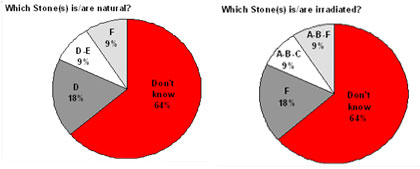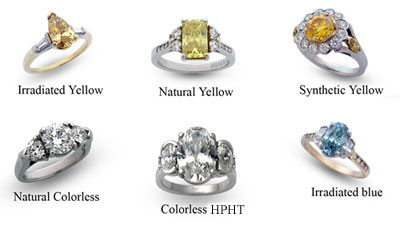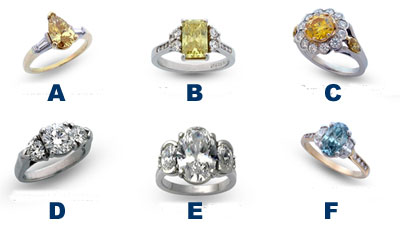Synthetic Colored Diamonds
 Fancies, those vividly colored diamonds so rare in nature that their prices
are in the stratosphere, can now be made in a lab. Does it really matter -
to the insurer or to the consumer - whether a fancy is mined or synthesized?
Fancies, those vividly colored diamonds so rare in nature that their prices
are in the stratosphere, can now be made in a lab. Does it really matter -
to the insurer or to the consumer - whether a fancy is mined or synthesized?
How are fancies made?
HPHT (high pressure and high temperature), discussed in last month's issue as a treatment done to improve or remove color in diamonds, is also used to produce diamond itself. In this case, a "seed" of natural diamond is used as a base for growing diamond around it. Once grown, the diamond may be subjected to other procedures to change or deepen its color, yielding a rainbow of beautiful colors rarely found in mined diamond.
Other synthesizing methods are also used, and more are in the experimental stage.
Synthetic fancy colored diamonds are NOT imitations or simulants. They are genuine diamonds, with the same physical, chemical and optical properties as mined stones.
Yet skilled gemologists can recognize in these diamonds traces of their origin. For example, certain types of inclusions or characteristic color patterning (visible when the stone is studied with proper gemological equipment) indicate the process used to produce the stone.
Is disclosure necessary?
This is controversial in the jewelry industry. The issue there, as in the insurance industry, is economic.
In nature, fancy colored diamonds are extremely rare and their market price reflects this. In the lab, they can be produced in large quantities and with great predictability. Costs are lower for manufacture than for mining, and we can expect costs to go down as sales increase and technology improves.
Suppliers of natural diamonds feel that sales of natural fancies will suffer, and the public will be confused, if the market is flooded with synthetic stones that are not so identified.
Some diamond manufacturers, on the other hand, say that, since their products are real diamond in every sense, the distinction between mined and lab-grown is unimportant. They point out that subjecting carbon to high pressure and high temperature mimics how diamond is produced in the earth. The process is merely sped up — what took nature millions of years, takes only a day or two in the lab.
HPHT is used to grow synthetic diamond on a "seed" of natural diamond. This is similar to the way cultured pearls are produced, and it further blurs the distinction between natural and synthetic.
Yet many in the diamond trade hold that keeping the distinction is necessary.
Because that distinction involves a great difference in valuation, to the
insurer (and consumer) disclosure is vital. Synthesized diamonds are worth
less than natural diamonds of similar appearance, and the high price of natural
fancy diamonds makes this price difference immense.
Gemesis, the first company to market gem-quality synthetic stones, has its name inscribed on all its diamonds over 0.25 carats. This is a good-faith gesture by the manufacturer, but others down the buying chain (distributor, retailer, appraiser, buyer) may remove the inscription and pass off a synthetic gem as natural. Note that it's the insurer who suffers if there is a break in the chain of disclosure.
What other word says "synthetic"?
Gem manufacturers like to avoid using the word synthetic. Though it simply means "put together," consumers often think synthetic signifies that the diamond is not real. Diamond producers are introducing alternate terms they hope consumers will find appealing.
Cultured diamonds, comparable to cultured pearls, has been gaining usage. This designation suffered a setback earlier this month, when a court in Germany ruled its usage illegal, presumably because its meaning was not clearly descriptive. Manufacturers argue that production methods conform to the definition of cultured: "grown in a prepared medium" or "produced under artificial and controlled conditions."
The German court ordered distributors to use either synthetic or artificial. The court's ruling is expected to have repercussions throughout the European Union countries, but no U.S. court has yet ruled on terminology for synthetic gems.
Apollo, an important producer of synthetic diamonds, argues that the terms artificial and synthetic mislead the public into assuming such gems are something other than real diamond. One representative said the German court's decision ignores the advancements in science.
Many of the issues surrounding synthetic diamond are similar to those faced decades ago by synthetic emerald. In 1938 Carroll Chatham developed a process for growing emeralds. Industry politics resulted in the FTC preventing Chatham from calling his gems Chatham Emeralds or Cultured Emeralds, so he wound up calling them Chatham Created Emeralds. Today Chatham's grown emeralds are synonymous with the finest of synthetic emeralds (and the company is also growing diamonds!).
Meanwhile, gem manufacturers are hoping their terms will catch on. Some describe their gems as lab-grown. Gemesis calls its diamonds Gemesis-created.
Bottom Line
For insurers, the important point is that the jewelry industry sees a difference between gems from a mine and gems from a lab, and it values them differently. Synthetic diamond is worth far less, and as technology improves, we can expect its market price to drop even further. The difference in valuation between synthetic and natural diamond, already immense, is bound to increase.
FOR AGENTS & UNDERWRITERS
In insuring colored diamond jewelry, never assume the gem is natural (and
therefore more valuable). Insist on an appraisal that explicitly states whether
the stone is natural or synthetic. (ACORD 78/79
appraisals warrant that the gems described are natural unless otherwise stated.)
For fancy colored diamonds, a price that is "too good to be true"
is a major red flag. Do ITV (insurance to value) calculations to check for
a major discrepancy between the purchase price and replacement cost. JEMs
software makes ITV calculations easy and guards against fraud.
Any colored diamond approaching .5 carat should come with a certificate from an independent laboratory, such as the Gemological Institute of America (GIA) or the American Gem Society (AGS).
Having a trustworthy appraisal is especially important for fancy colored diamonds because of the great value difference between synthetic and natural ones. Here, as for all high-value jewelry, it is best to have two appraisals. At least one of them should be written by a Certified Insurance Appraiser™, an experienced jeweler who is a Graduate Gemologist and is also trained in appraising for insurance.
Even though synthetic fancies resemble natural diamonds, a CIA™ has the training and experience to recognize when something is suspicious. He will be wary of a diamond that is too perfect and will know when too much of a rare gem starts showing up on the market. If he suspects the gem is synthetic, he can connect with a recognized independent lab (such as GIA Gem Trade Lab or AGS Lab) that has equipment to definitively identify synthetic diamond.
FOR CLAIMS
Look over the appraisal for terms that signify synthetic, such as: cultured, artificial, created, grown, lab-grown.
ACORD 78/79 appraisal forms warrant that the appraised gems are natural unless otherwise stated. If you are working with a non-ACORD appraisal, don't assume a colored diamond is natural simply because the appraisal doesn't mention synthetic (or one of the equivalent terms). The appraisal should state that the gem is either natural or synthetic.
If the appraisal is not on ACORD 78/79, use ACORD 18 to verify that all necessary descriptive information is given.
For fancy colored diamonds, a price that is "too good to be true" is a major red flag. Do ITV (insurance to value) calculations to check for a major discrepancy between the purchase price and replacement cost. JEMs software makes ITV calculations easy and guards against fraud.
A few synthetic-diamond manufacturers are mentioned above, but there are others and the list is growing. If the appraisal or sales documents list any brand names, it is worth checking with your jewelry insurance expert as to what the names might signify (e.g., Lindy sapphire, Chatham emerald, Bellaire diamond).
Be suspicious if all you have to work with is an appraisal written by the seller. Any colored diamond approaching .5 carat should come with a certificate from an independent laboratory, such as GIA Gem Trade Lab or AGS Labs.
NEWSFLASH!! SURVEY RESULTS
JCRS recently did a survey showing 6 diamond rings. We asked: Which gems are natural? Which are irradiated? Which are HPHT treated? Which are synthetic? Here's how the respondents answered.


And, here is who took the survey.

Congratulations to Graduate Gemologists!!
As a group, these trained professionals gave the correct answer:
Don't Know.
It is impossible to know from a picture whether a gem is natural, synthetic or treated. It is impossible to know without performing appropriate tests using gemological equipment.
The gems shown in the quiz are properly identified below.
Note to insurers: You may want to take the test yourself before looking at the answers. After all, in judging a picture, your guess is as good as anyone else's.
But when insuring scheduled jewelry, you want an appraisal from a professional whose opinion is worth more than "anybody's guess." A Certified Insurance Appraiser™ is a Graduate Gemologist, trained in jewelry appraising for insurance, who warrants that all jewelry is inspected in a gem lab, using appropriate gemological equipment.
Gems Identified

©2000-2024, JCRS Inland Marine Solutions, Inc. All Rights Reserved. www.jcrs.com


